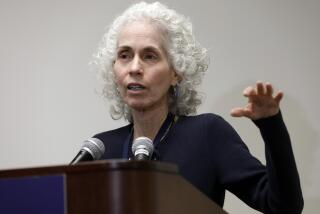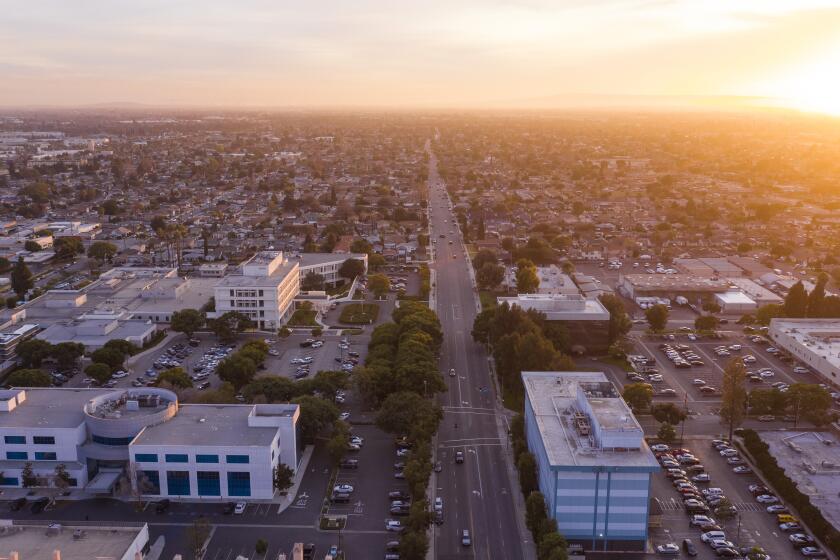Fumbling on AIDS Causes Waste, Suffering
- Share via
Los Angeles County’s health-care system is increasingly unable to meet the needs of those who use it. People experience long waits for initial visits to outpatient clinics. It is not uncommon for a hospital patient to spend up to three days lying on a gurney in a hall until a bed becomes available. The system does not employ sufficient bilingual staff, so people who speak a language other than English often have difficulty gaining access to medical services. However, since we are most familiar with the problems of people with AIDS and AIDS-related illnesses who must use the public health facilities, we will speak specifically to their problems.
The county has yet to comprehensively address the AIDS epidemic in a medically sound, fiscally responsible and compassionate manner. As a result, people are dying in unnecessary pain and emotional agony. With one-third of all people with AIDS and AIDS-related illnesses relying on this system, it is no surprise that they receive substandard care.
For years, the breakdown of the county’s public health-care system has been obvious. Why have our public officials chosen to do nothing about it? When their inaction is criticized, they become defensive and reactive rather than creative and responsive.
Who is in charge here? Nobody, it seems. The Board of Supervisors relies on whatever information or misinformation our county Department of Health Services provides. The Department of Health Services hides behind very real and enormous problems in the public health-care system instead of providing positive and constructive solutions. Monies are provided but not spent; $8.6 million go unused in this year’s county AIDS budget. Services continue to go unprovided, facilities unrehabilitated, staff unrecruited and more patients continue to suffer and die needlessly.
Since the epidemic began nine years ago, the county’s only major organized response has been to open an outpatient clinic, which has proved grossly inadequate. It is so overburdened that one must wait eight weeks for an initial visit. People with temperatures of 103 or higher sit for hours on hard wooden benches waiting for help. Some receive chemotherapy in crowded hallways, vomiting in bags. Others in the same hallways, stripped to the waist, have IVs hooked to their arms. A caring staff does its best amid these poor conditions.
Faced with the harsh reality of the outpatient clinic and with the lack of a dedicated AIDS ward and other health-care services, AIDS activists organized a grass-roots campaign to bring about sorely needed change. In 1988 a series of protests were organized to bring pressure on the Board of Supervisors and on the county Department of Health Services. The outcry was heard but the response meager: a 20-bed AIDS research ward to open sometime in 1990. The planned ward is already obsolete in the face of a current average daily census of 60 hospitalized patients with AIDS and AIDS-related illnesses.
California’s Department of Health Services recently reported that during 1988 the state Medi-Cal program spent twice as much money per AIDS patients in Los Angeles as it did for those in San Francisco. This is due primarily to the extended hospital stays that occur in Los Angeles: 13.3 days against 9.5 days in San Francisco. The report is an indictment of poor patient management, resulting in part from the lack of a dedicated AIDS ward in this county’s public hospital system. Studies have shown, and the experience of private hospitals in Los Angeles has proved, that the length of hospital stay for patients in AIDS wards is shorter than for AIDS patients dispersed in the general hospital population. Health-care systems in other cities have a range of health care for people with AIDS and AIDS-related illnesses, which includes dedicated AIDS wards, outpatient clinics, early intervention prevention programs, hospices and home health-care programs.
Are we in Los Angeles entitled to anything less? Yes, according to our Department of Health Services and Board of Supervisors. No, according to community groups who participated in the recent weeklong AIDS vigil at County/USC Medical Center. In the rain and cold, the community demanded a 50-bed AIDS ward, improved outpatient services, a comprehensive countywide AIDS health-care plan, access to the treatments and health monitoring routinely available under private care, and full disclosure of the possible health risks in county drug-research protocols.
We are in the midst of an epidemic that will take us beyond the year 2000. While it should be practicing 21st-Century medicine, this county’s health-care system continues to function in a 19th-Century modality in early 20th-Century facilities. The Board of Supervisors has shown itself incapable either of meeting the county’s immediate health-care needs or of anticipating those of the future. The county Department of Health Services must cease its arrogant posturing and be willing to provide what is needed in terms of public health. The supervisors must meet their obligation to provide for the public health and insist that those they have hired to do that job do it and do it well.
More to Read
Sign up for Essential California
The most important California stories and recommendations in your inbox every morning.
You may occasionally receive promotional content from the Los Angeles Times.













